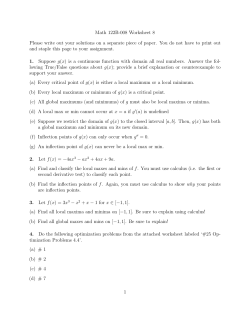
Practice Final Exam
Math 1220: Calculus 1 Practice Final Exam Course Summary 1. Basic Theory of Calculus • know the meaning of the slope of a curve and understand the difficulty in precisely defining the tangent line to a curve • be able to sketch slope and area graphs for a given curve • how to recover a sketch of f from given sketches or sign data for f 0 (and f 00 ) • the relationship between slope and area: what the Fundamental Theorem of Calculus is, and why it is true. 2. Computing Derivatives and Antiderivatives • know the derivatives of basic functions such as: powers of x; trigonometric functions; exponential functions; logarithmic functions; inverse trigonometric functions • be able to apply the basic rules to compute derivatives of sums, products and compositions of the basic functions • be able to ‘reason backwards’ and use your knowledge of derivatives to find antiderivatives 3. Evaluating Definite Integrals • know how to use your power to find antiderivatives to evaluate definite integrals • use the geometric meaning of definite integrals to evaluate or estimate their values 4. Linear Approximation • be able to apply the linear approximation technique; this includes being able to make a good choice of reference point • be able to give a rock-solid, clearly justified upper bound for the error of your approximation 5. Using Calculus to Solve Actual Problems (a) Related Rates Problems • be able to take a problem described in English and convert it to a problem of calculus; this includes providing enough explanation that the conversion can be understood and verified by an independent reader; it also includes being able to take the situation described in the problem and extract one or more equations from it • be able to solve the resulting calculus problem (b) Optimization Problems • be able to take a problem described in English and convert it to a problem of calculus; this includes providing enough explanation that the conversion can be understood and verified by an independent reader; it also includes being able to take the situation described in the problem and extract one or more equations from it • be able to solve the resulting calculus problem (c) Integration • integration allows you to solve difficult problems by cutting them into tiny easily solved pieces, and then adding the results; be able to apply this technique to a convert (with explanation) difficult problems into integral problems. • be able to solve the resulting calculus problem (if the finding the antiderivative is not beyond what we’ve learned) Math 1220: Calculus 1 Practice Final Exam Spring 2015 Reminder: Full credit will only be given for clearly and fully explained solutions. Problem 1 Here are the graphs of the functions g 0 and g 00 . (a) Decide which is which, and explain how you know. (b) Use the graphs to sketch the graph of g. Problem 2 (a) Here is the graph of f . Sketch the slope graph for f . (b) Here is the graph of h. Sketch an area graph for h. Problem 3 (a) What does the Fundamental Theorem of Calculus say? (b) Why does the Fundamental Theorem of Calculus help you to evaluate areas? Problem 4 Evaluate the following derivatives. (a) 2 d (ex ). dx (b) (cos(sin(ex )))0 (c) d (cos(t) sin(t)et ) dt Problem 5 Evaluate the following integrals. R2 (a) 1 x3 + sin(x) − ex dx R1 2 (b) 0 xex dx Problem 6 2 4 (a) Use calculus to graph f (x) = 1 − x2 + x24 . Be sure to determine where f is increasing, decreasing, curving up, curving down, etc. (b) What are the minimum and maximum values of f (x) for x between −4 and 1? Problem 7 Here is a problem: The beauty of a rectangle with side lengths x and y is given by the expression sin2 ( xy ). Find the dimensions of the most beautiful rectangle that can be inscribed in a circle of radius 5. Convert this to a pure calculus problem. Be sure to explain clearly why your pure calculus problem will answer the question. Problem 8 Here is a problem: One highway crosses over another at right angles. At a certain moment a car is 1 mile away from the overpass and approaching it at at 70 miles per hour. At the same time a truck is 2 miles from the overpass and travelling away from it at 65 miles per hour. Are the car and the truck getting closer together or farther apart at this moment? Convert this to a pure calculus problem. Be sure to explain clearly why your pure calculus problem will answer the question. Problem 9 Here is a problem: At time t = 1, I am being chased by a bear. As I run, terrified, through the woods, I notice that I am collecting burrs on my pants. When the underbrush is very dense, I collect burrs more quickly, and when it is more clear, I collect them less quickly. I observe that at time t I am collecting burrs at a rate of 1 t +4 + burrs per minute. b(t) = 10 − 5 cos 5 t The bear finally catches up to me at time t = 5. When a hiker finds my mauled body, how many burrs are stuck to my pants? Set up an integral that will solve the problem. A clear and complete explanation must involve an analysis of the ‘microscopic’ situation. Problem 10 (a) Use a linear approximation to estimate √ 3 7. (b) Give a rock-solid upper bound for the error of your approximation. Problem 11 Use the geometric reasoning to answer the following questions. R3√ (a) Evaluate 0 12 − x2 dx. R2 (b) Find upper and lower bounds for 1 2x dx.
© Copyright 2025











